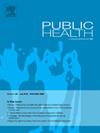丹麦室内环境的社会经济模式:2000 年和 2021 年的横截面研究
IF 3.9
3区 医学
Q1 PUBLIC, ENVIRONMENTAL & OCCUPATIONAL HEALTH
引用次数: 0
摘要
研究设计来自 2000 年和 2021 年丹麦健康和发病率调查的横断面数据。方法该研究包括 27,068 名参与者。室内环境指标(霉菌、温度、通风、交通和邻居噪音造成的烦恼,以及是否存在水渍)通过问卷调查(2021 年)和部分访谈(2000 年)获得。社会经济地位包括房屋所有权、教育水平和家庭收入。结果从 2000 年到 2021 年,因气流、温度和噪音造成的烦恼的发生率显著增加(例如,温度为 5.9%-25.1%,几率比(OR)为 6.72,95% 置信区间(CI)为 6.12-7.38),而水渍的发生率则有所下降(17.7%-13.8%,OR 为 0.85,95% 置信区间(CI)为 0.76-0.96)。发霉造成的烦恼没有差异(2000 年为 3.1%,2021 年为 2.5%,OR 为 0.90,95% CI 为 0.69-1.17)。按收入而非教育水平进行评估时,在热量条件、噪音引起的烦恼和是否存在水渍方面存在社会不平等。在 2000 年和 2021 年,低收入人群的室内环境状况更为普遍。在家庭收入方面,室内环境差的所有指标都存在社会不平等现象,而在教育水平方面,不平等现象则不那么明显。本文章由计算机程序翻译,如有差异,请以英文原文为准。
Socioeconomic patterns in indoor environment in Denmark: cross-sectional studies from 2000 and 2021
Objectives
To examine changes and socioeconomic patterns in indicators of a poor indoor environment in 2000 and 2021.
Study design
Cross-sectional data from the Danish Health and Morbidity Survey in 2000 and 2021.
Methods
The study included 27,068 participants. Indicators of indoor environment (annoyances from mould, temperature, draught, traffic and neighbour noise, and presence of water damage) were obtained from questionnaires (2021) and partly by interview (2000). Socioeconomic status included home ownership, educational level, and household income. The degree of social inequality in the indoor environment was estimated using the concentration index of inequality.
Results
The prevalence of annoyances due to draught, temperature, and noise increased significantly from 2000 to 2021 (e.g., temperature 5.9%–25.1%, odds ratio (OR) 6.72, 95% confidence interval (CI) 6.12–7.38), whereas the prevalence of water damage decreased (17.7%–13.8%, OR 0.85, 95% CI 0.76–0.96). No difference was seen in annoyances due to mould (3.1% in 2000 and 2.5% in 2021, OR 0.90, 95% CI 0.69–1.17). Social inequality was present for thermal conditions, annoyances due to noise and presence of water damage when assessed by income but not by educational level. Conditions were more prevalent among individuals with low income in both 2000 and 2021.
Conclusions
The proportion of individuals reporting a poor indoor environment due to thermal conditions and noise increased in the period 2000–2021. Social inequality was observed in all indicators of a poor indoor environment for household income, whereas the inequality was less pronounced when assessed by educational level.
求助全文
通过发布文献求助,成功后即可免费获取论文全文。
去求助
来源期刊

Public Health
医学-公共卫生、环境卫生与职业卫生
CiteScore
7.60
自引率
0.00%
发文量
280
审稿时长
37 days
期刊介绍:
Public Health is an international, multidisciplinary peer-reviewed journal. It publishes original papers, reviews and short reports on all aspects of the science, philosophy, and practice of public health.
 求助内容:
求助内容: 应助结果提醒方式:
应助结果提醒方式:


